The Maternity Outfit - 1909
Last year coming home from Europe I crossed on the steamer with an attractive young married woman who was admired for her great beauty, her high spirits and many other charming qualities that made her a most delightful companion.
The last day out, there were the usual gymkhana races, dance, and concert with which ocean voyagers celebrate the parting of the ways at the end of a pleasant trip.
Foremost among the merrymakers was this young American, a lithe, active figure in a well-cut, well-tailored suit in the daytime and radiantly lovely at night in a black chiffon Empire dress that she had made in London.
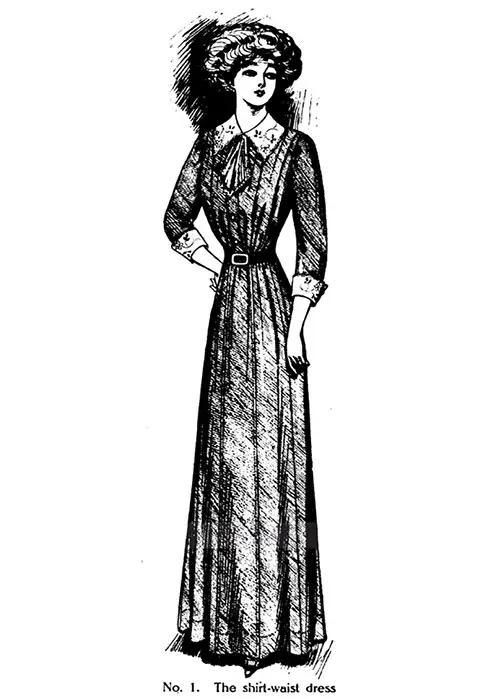
You can imagine my surprise when I met her, several months later, driving in Central Park with a most bewitching baby. We had sat at the same table, lain in parallel deck chairs, and had indeed seen quite a bit of each other on the way home, and yet, as I told her, I had never suspected it for a moment.
I was very much interested at once, for I thought she had been unusually successful in meeting an inconvenient situation. Her wardrobe had been of the most straightforward description. It consisted of a beautifully made pongee suit which she wore with the coat all day long.
Warm days she wore the thinnest kind of lingerie waists under the coat; in cool weather, a lined waist of the pongee. Besides her suit she had two or three evening dresses—all of them high waisted and with soft, full skirts and with a fichu-like drapery that gave her added width across her shoulders and tended to keep her figure to its normal proportions.
As far as giving her a complete disguise, I could find nothing to criticize in her outfit. However, for hygienic reasons, I think she would have been wiser to have chosen for her hacking suit a dress that was suspended entirely from the shoulders.
It is my belief, backed by the authority of many prominent physicians that a woman at this time should never carry the slightest unnecessary weight at the waistline.
During the last five or ten years, there has been—in the large cities, at least— noticeable improvement in the clothes worn by married women.
The new maternity garments conceal the figure perfectly and allow women to go about in a sane, natural manner. The old morbid, recluse-like banishment that women used to accept as their lot is rapidly becoming one of the antiquated ideas that belong to a less enlightened era.
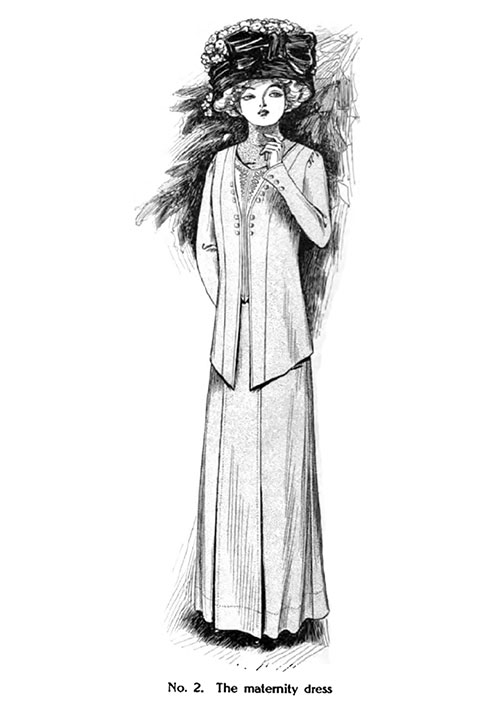
The change is undoubtedly for the better, and the next generation of children will undoubtedly show the effects of a wiser, more wholesome régime.
The city-bred woman has been the first to benefit by the new ideas and theories just because they have reached the cities before they have penetrated the country districts, where new methods are slower of access and acceptance.
It is mainly for the women who have not had the possibilities of the present-day maternity outfit brought to their attention that I have taken up the subject for this lesson.
The first thing that a woman will need is an everyday out-of-doors dress or suit of some kind, for it is essential that she should keep in the open air at least a couple of hours a day.
Most women use a skirt and shirt-waists—a combination that I do not altogether favor, for, as I said before, a complete dress with the weight resting on the shoulders is a far more healthful sort of a garment than one in which the skirt is supported at the waistline.
However, for the Summer this objection cannot be urged quite so strongly, as tub materials, linens, pongees, and lightweight mohair do not make a burdensome dress. Even in a combination of this kind, however, I do not advise a skirt of one color and waists of another.
It draws a sharper line of division in the figure than a one-color scheme carried out as shown in the first illustration.
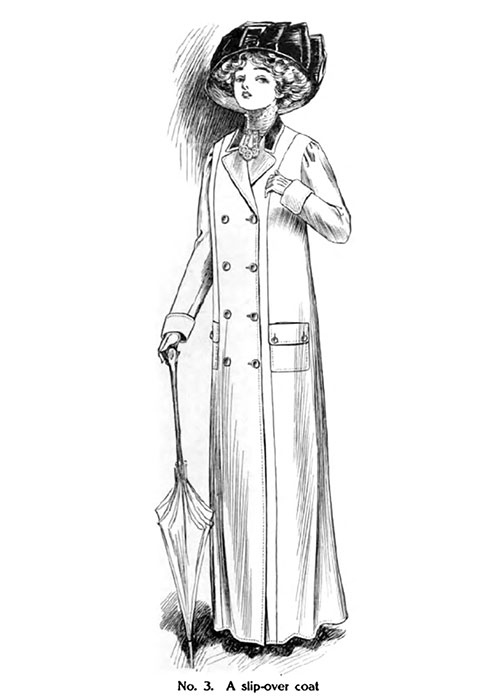
There is nothing different in the construction of this shirt-waist from that of the one I described in such detail in the lesson on the tailored shirt-waist of last August.
The arrangement of the tucks is a little different, and the sleeves can be made in the three-quarter length which is more comfortable for Summer than the full-length sleeve with the stiff, mannish cuff.
The bodice has a little fullness at the waistline in the back, which should be drawn into a belt tape that you can fasten around the waist, holding in the fullness in the front. The belt tape is much better than the belt stays, which would have to be altered from time to time.
The skirt is a regular maternity model with a moderate fullness at the top—just a little across the front, but a trifle more at the sides and back. It is in nine gores, with a deep adjustable plait at each side of the front breadth which can be let out little by little.
The top edge of the skirt slopes upward from the back to the center of the front so that the length will always be plenty long which can be conveniently adjusted at the front of the skirt. Otherwise, the skirt would hang in an ugly manner across the front.
For a shirt-waist suit, the skirt should be cut in the round length—never shorter, unless you are going to use it merely for rainy days. A short skirt is awkward in a maternity dress and makes a woman look worse than is at all necessary.
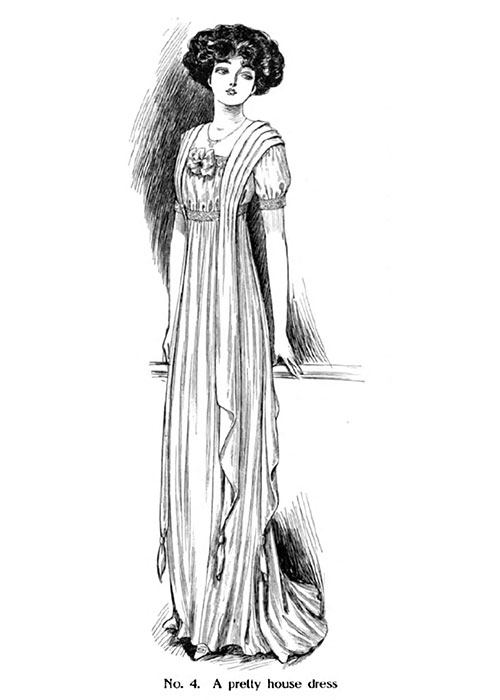
The method of making the skirt is the same as for any gored skirt pattern except that there is no need to fit it into the figure over the hips and at the waist. It is mounted on an elastic band run into a casing—a self-adjustable affair that takes care of itself very nicely. The deep plaits at the front gore are quite easy to handle.
You crease the skirt at each straight line of single small perforations and sew in a tuck a quarter of an inch from the crease.
A line of single large perforations marks the first position for the plait. Bring the crease over to this line and slip-stitch it down from the underside. To increase the size of the skirt, you must rip out the slip-stitching, move the crease nearer the center of the skirt and slip-stitch it again in place.
While the shirt-waist suit is impeccable and practical, I lean strongly toward the maternity dress shown in the second illustration. It looks quite a little like a semi-tailored suit.
In reality it is a dress consisting of a seven-gored, high-waistline skirt mounted on a French waist-lining, and a coatee that can be of the same material as the skirt if one uses it for an everyday sort of dress, or of dyed lace, net, soutache tulle, etc., if one wants it for receptions or formal occasions.
It is a gorgeous dress for linen, pongee, lightweight serge, Henrietta, cashmere or silk for the Summer and early Fall and heavier materials for colder weather.
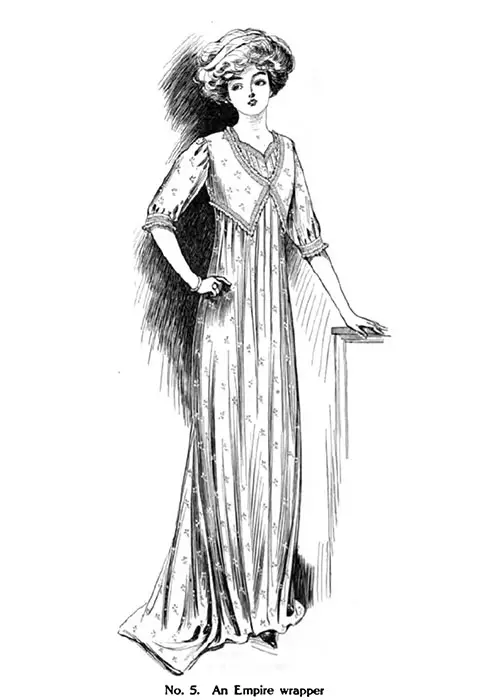
One should never use a material that has any great weight for a maternity dress, for heavy clothes are very apt to give a woman a dragged, tired feeling.
The French bodice lining should be made of some durable material. A superior quality percaline is better than a silk for you can place greater reliance in its wearing qualities. It is made and fitted quite like an ordinary lining save that I would suggest giving it a slightly more comfortable fit than under ordinary circumstances.
The pattern should be altered, if necessary, put together and fitted like the waist-lining of the bodice in the December lesson.
After the lining has been fitted, the under-arm seams should be pressed open and bound. The correct basting line in the center and side-front seams should be marked with tailors' tacks or chalk.
Cut four strips of lining on the bias, making each strip three and a half inches wide and a bit longer than the side seams of the front and back. Baste a strip to the underside of the side-front seam with the raw edges together.
Baste and stitch them three-eighths of an inch back of the edge. This forms a small plait under each seam. (Illustration No. 7.) In sewing on the bias strip, one must be particularly careful to ease it over the bust on the outer edges of the side seam.
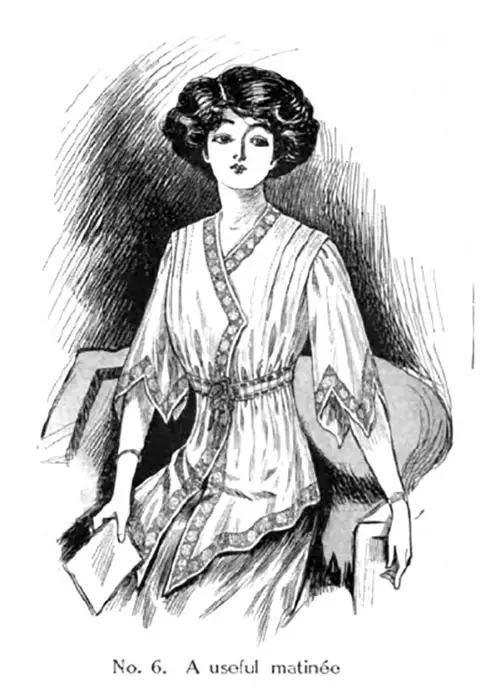
In sewing the strip to the second edge of the side seam—the edge nearer the center front—the bias band should be stretched at the bust to make it easy over the curve of the figure. Baste the second bias strip to the second side seam in the same way as the first.
Take out the basting threads in the side seams and sew back three-eighths of an inch from the edges. This gives you a small fold on which to work the eyelets for the lacing of the fronts.
The other two bias strips are used to finish the side-back seams of the lining. They are handled just like the side-front seams and are also laced together instead of being stitched.
The edges of the center front closing are under faced with bias strips and worked with eyelets. The edges of the center-back seam are closed in an ordinary seam.
The eyelets should be placed an inch and a quarter apart and a quarter of an inch in from the edge of the fold. (Illustration No. 7.) They are made with a stiletto and worked with the ordinary buttonhole stitch. They should be laced with a cord or elastic so that they can easily be let out.
After the eyelets have been worked, the front seams should be boned just back of the line of lacing. The other seams are boned in the usual manner—the method is described fully in the December lesson.
There is nothing at all difficult in the construction of the little coatee or over It is semi-fitting, waist, so your only care will be to make it neatly and trim it prettily. It has no lining, and you will not have the slightest trouble in handling it. It serves the double purpose of a waist and coat.
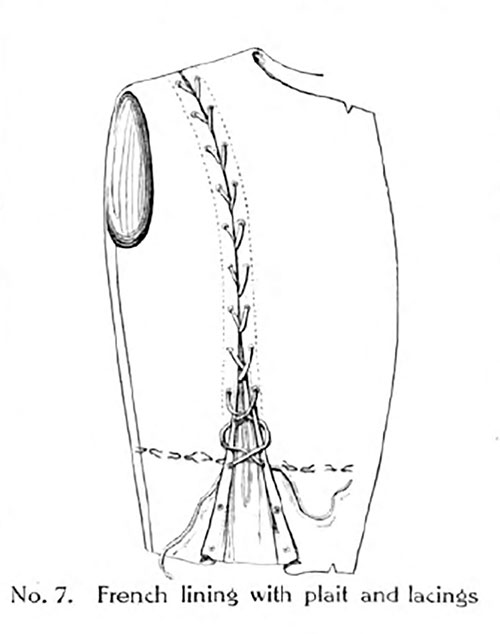
The skirt is made, fitted, and joined to the lining body like the high-waistline skirt in the February lesson except that it is mounted directly on the lining and not on a separate bodice stay.
There is a deep adjustable plait at each side of the front gore. (Illustration No. 8.) It is made by creasing at the line of small upright perforations and stitching the fold a quarter of an inch back of the crease.
The crease is then brought over to the line of large single perforations and slip stitched down from the underside of the skirt. Do not use machine-stitching or your material will be marked with the stitching when the plaits are let out.
The slip-stitching should stop at the second perforation from the bottom, leaving an open plait or kick out at the bottom. (Illustration No. 2.)
Even with a dress of this kind, which for the Summer, at least, meets most of the ordinary requirements of a coat suit, one should have some long coat or wrap for traveling, driving, etc. I should recommend a straight slightly fitted jacket made with generous overlapping double-breasted fronts. (Illustration No. 3.)
It is an easy thing to move the buttons, and the coat will always look well. It is an amazingly simple coat to make, for it is very slightly fitted and extremely severe in cut.
Either the October lesson on the tailored coat for Fall and Winter or the May lesson on the unlined jacket will give you all the information needed about its construction.
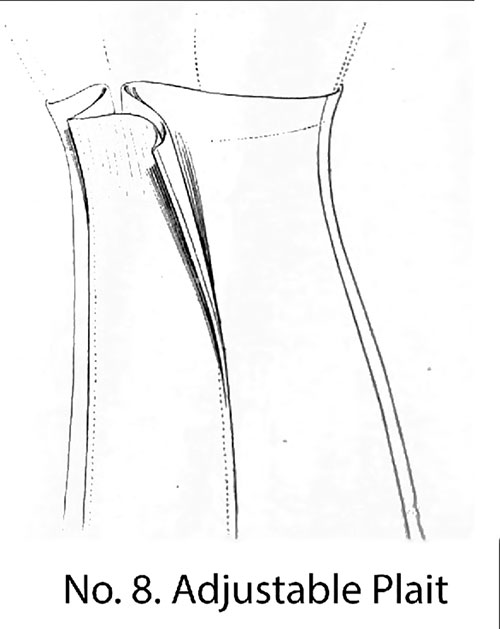
The mothers of this year are particularly lucky, for the present styles lend themselves very kindly to their needs.
The slightly fitted coats and Empire wrapper can make the expectant mother appear in public without the slightest feeling of annoyance or discomfort. The little house dress in Illustration 4 is a pretty thing and can be put to any number of uses.
Décolleté and with short sleeves, it makes a graceful sort of dress for home dinners in any soft material crêpe de Chine, chiffon, mull, batiste, etc. High-necked it makes an excellent day dress in the pretty Summer stuffs or wool batiste, cashmere or Henrietta for the Fall or Winter.
I believe the skirt, for this kind of an outfit, is better gathered than tucked, as shown in the illustration, though it can be used either way. The gathers are softer and more disguising.
I would recommend arranging the darts in the front of the lining so that they can be laced like the seams of the French lining of the maternity dress.
Gather the lower edge of the outside front and sew it to a narrow casing about six inches longer than your ordinary measure at the high waistline. Gather the top of the skirt and join it to the lower edge of the outer waist.
Run a drawing-string in the casing, and you will have a simple method of adjusting the belt of your dress.
Illustrations 5 and 6 are unique types of wrappers and matinées for maternity needs. The Empire styles are by far one's wisest choice wherever it is possible to use them, not only because they are pretty and protecting to the figure, but because the weight of the garment falls on the shoulders.
I would make the belt of the dressing-sack about six inches longer than the usual size and draw it in on a ribbon.
The last three garments are so simple to make that they hardly come under the head of dressmaking at all. I have merely given them because they are an essential part of a maternity outfit, and women are continually asking me for suggestions along this line.
My entire idea has been in this lesson to give you some practical advice on the choice of clothes that will be attractive, comfortable, and sanitary. I have had enough correspondence on the matter to make me feel justified in giving a chapter to it, although, strictly speaking, it has not been a dressmaking lesson.
The earlier dressmaking lessons appearing in THE Delineators are as follows:
- The Unlined Frock July 1908
- The Shirt-Waist Aug. 1908
- The Sailor Dress Sept. 1908
- The Tailored Coat for Fall and Winter Oct. 1908
- The Gored Skirt Nov. 1908
- The Fitted Waist Dec. 1908
- The Evening Coat Jan. 1909
- The High Waistline Skirt Feb. 1909
- The Composite Costume (One-Piece) - March 1909
- Fitted Linings (For figures that are hard to fit) April 1909
- The Unlined Coat May 1909
- The Circular Skirt June 1909
Chalmers, Eleanor “Dressmaking Made Easy: XIII—The Maternity Outfit,” in The Delineator, New York: The Butterick Publishing Company, Vol. LXXIV, No. 1, July 1909, p. 62 - 64.
Editor's Note: Some terminology used in the description of women's clothing during the 1800s and early 1900s has been changed to reflect more modern terms. For example, a women's "Toilette" -- a form of costume or outfit has an entirely different common meaning in the 21st century. Typical terms applied to "toilette" include outfit, ensemble, or costume, depending on context.
Note: We have edited this text to correct grammatical errors and improve word choice to clarify the article for today’s readers. Changes made are typically minor, and we often left passive text “as is.” Those who need to quote the article directly should verify any changes by reviewing the original material.
